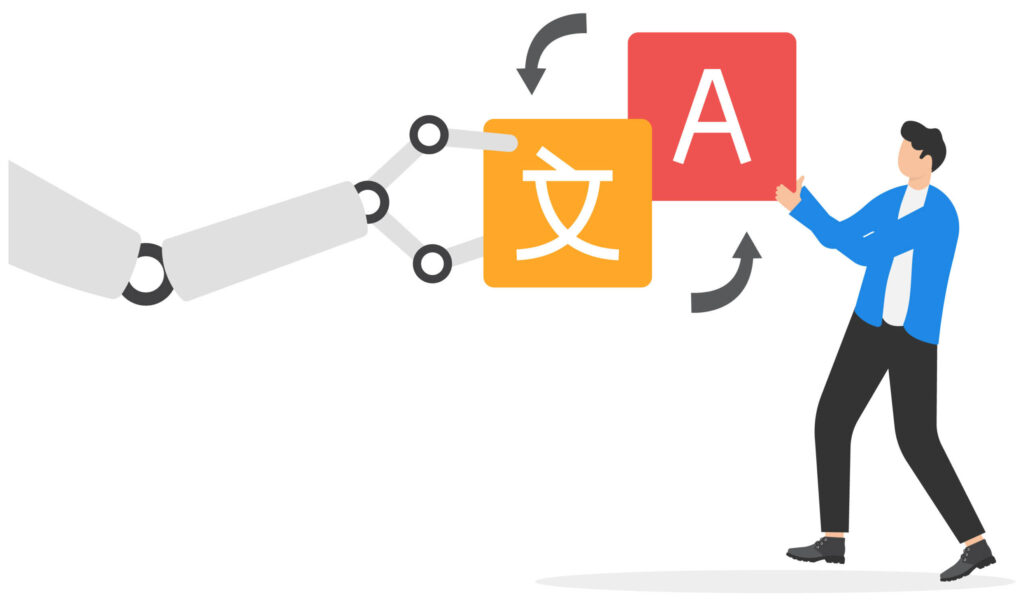
The conversation around AI in our industry has often been framed as a binary: Will it replace human translators, or won’t it? Some fear it might. Others see it as a powerful opportunity. But that debate is becoming less relevant with each project we deliver. AI is already here — embedded in Machine Translation engines, QA automation workflows, and content routing tools — not as a replacement, but as a component of how we work.
So the real question isn’t whether to use AI. It’s how to use it well. Which parts of the process genuinely benefit from automation? Where does it reduce friction, and where does it create more work? And most importantly: how do we ensure that what’s gained in efficiency doesn’t come at the cost of clarity, tone, or purpose?
This shift in focus, from potential to practicality, is where meaningful adoption happens. It’s less about what AI can do in theory, and more about what it actually improves in a real-world localization cycle.
Understanding how AI fits into different content types means focusing on usability: What’s the goal of the content? Who’s the audience? How much context does the content carry — and can AI handle it reliably, or is a human still best equipped to make that call?
This kind of thinking moves us away from broad claims about what AI ‘can’ or ‘can’t’ do, and closer to a practical assessment of when it actually improves the process — and when it doesn’t.
AI Beyond MT: Adding Structure, Not Replacing It
We sometimes talk about MT and AI as separate things, but they’re not. MT is AI — a narrow, focused application that’s been part of localization workflows for years. When trained properly — using real client data, post-editing feedback, and domain-specific glossaries — MT delivers results. It’s predictable. Scalable. Efficient. Especially when you’re working with high-volume, structured content.
But what’s changed is what we can build around MT now. Broader AI systems — large language models, classifiers, NLP pipelines — can help us shape the workflow upstream and downstream. They can flag risky input before it hits the engine. They can assess output and route it based on complexity or tone. They can help teams focus on what needs human judgment, rather than asking them to comb through everything manually. That’s where AI adds value — not by replacing MT, but by making the workflow more intentional.
Not all content is up for debate — and AI shouldn’t decide what gets localized
Some AI solutions are built to optimize for efficiency by analyzing large batches of content and deciding what to translate — and what to leave behind. In theory, this sounds useful. But in practice, it creates real problems for clients whose content doesn’t lend itself to that kind of filtering.
In healthcare, you can’t just choose to skip sections of a discharge summary because they weren’t marked as “high priority.” In education, you can’t tone-shift a message to parents and assume it will still land. In legal, there’s no such thing as “good enough.” In these spaces, every word can carry risk, weight, or responsibility — and what looks like optimization on paper might translate into confusion or even liability for the client.
The decision to localize isn’t just about content volume or user engagement. Sometimes it’s about compliance, or equity, or basic clarity. And in those cases, AI doesn’t get to decide what matters. That responsibility still sits with people — and with the organizations that serve those audiences.
Let AI Flag Patterns — Leave Decisions to Humans
AI does have a place — a valuable one — when it’s scoped correctly. But the value looks different depending on who’s using it.
For clients, AI can support content audits, highlight inconsistencies in their source materials, or pre-validate tone and structure before localization even begins. For example, it can identify discrepancies that might affect brand consistency — for instance, when product naming conventions used in marketing campaigns differ from those in onboarding emails or UI labels. Left unchecked, these inconsistencies can confuse users and dilute brand clarity across markets.
For linguists, it can assist with terminology identification, detect formatting gaps post-MT, or surface content with potential tone drift — all without making the decisions for them. A typical use case might include flagging instances where a term appears with inconsistent translations across files, or identifying when formal register drifts mid-document in a way that could confuse readers.
What ties all these use cases together is that AI isn’t doing the linguistic thinking — it’s surfacing patterns, revealing inconsistencies, and giving stakeholders more visibility into the content they’re handling. The goal is to increase focus and reduce noise — not to bypass human oversight.
Smart Doesn’t Mean Automated
The goal of using AI in localization isn’t just to reduce effort — though in many cases, it absolutely should. The real opportunity lies in how that effort is redirected: toward more meaningful, higher-impact work. For translators, reviewers, and localization leads, AI should help free up time to focus on decisions that require expertise — not repetitive QA or content triage.
In a world where localization teams are scaling fast and juggling tight deadlines, AI can absolutely help keep pace. But the real value isn’t just in speed — it’s in how AI complements the rest of the workflow: making routine tasks lighter, helping prioritize more effectively, and offering visibility into large, messy content pipelines.
The challenge isn’t whether to trust AI — it’s how to implement it in a way that keeps the process efficient without compromising clarity, consistency, or control.
This piece was written by Nadim Abraham, Head of Language Quality for our Translation and Localization teams
